Post-It Reviews: Nonfiction about protests, refugees, activism, the water in Flint, and more
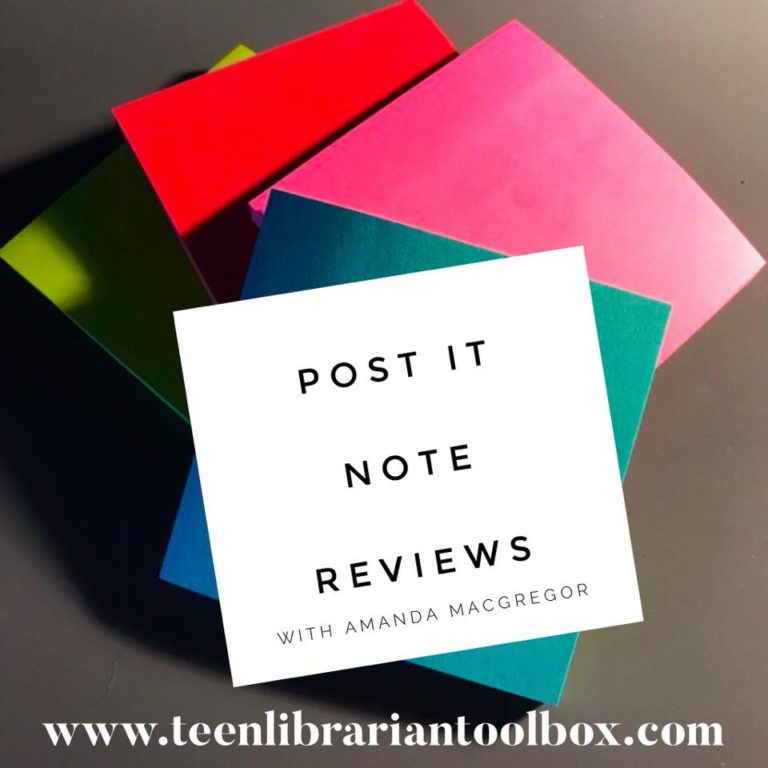
You’d think with reality being so unappealing these days, I’d be leaning more into fiction, but I have been reading a lot of nonfiction lately. My reading in general is slowing down—juggling distance learning and working and overwhelming amounts of anxiety really cuts into my reading time.
All descriptions from the publishers. Post-it note review follows the description.
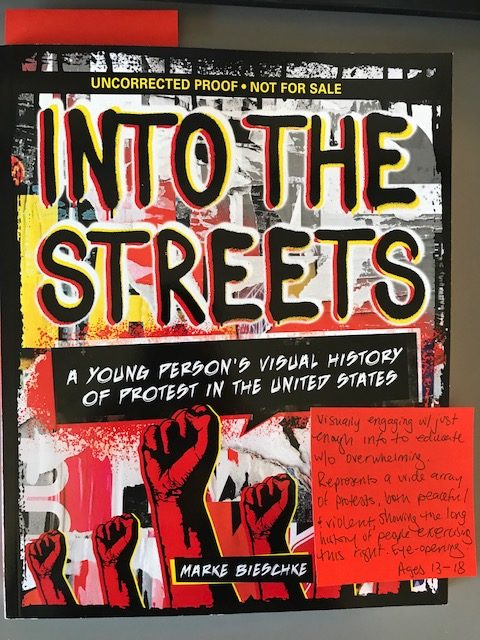
Into the Streets: A Young Person’s Visual History of Protest in the United States by Marke Bieschke (August 4, 2020)
This lively book guides readers through the art and history of significant protests, sit-ins, and collective acts of resistance throughout US history. Photos, artwork, signs, and other visual elements highlight the history of social action, from American Indian resistance to colonists through Black Lives Matter and Women’s Marches.
ADVERTISEMENT
ADVERTISEMENT
Into the Streets introduces the personalities and issues that drove these protests, as well as their varied aims and accomplishments, from spontaneous hashtag uprisings to highly planned strategies of civil disobedience. Perfect for young adult audiences, this book highlights how teens are frequently the ones protesting and creating the art of the resistance.
(POST-IT SAYS: Visually engaging with just enough info to educate without overwhelming. Represents a wide array of protests, both peaceful and violent, showing the long history of people exercising this right. Eye-opening. Ages 13-18)
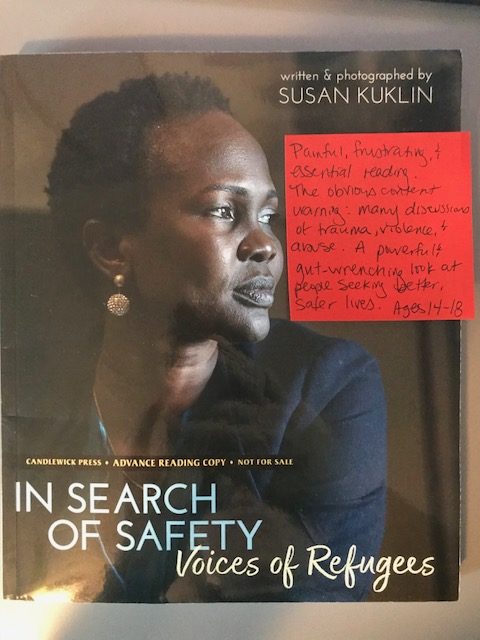
In Search of Safety: Voices of Refugees by Susan Kuklin
Five refugees recount their courageous journeys to America — and the unimaginable struggles that led them to flee their homelands — in a powerful work from the author of Beyond Magenta and We Are Here to Stay.
“From 1984, when I was born, until July 16, 2017, when I arrived in the United States, I never lived in a place where there was no war.” — Fraidoon
An Iraqi woman who survived capture by ISIS. A Sudanese teen growing up in civil war and famine. An Afghan interpreter for the U.S. Army living under threat of a fatwa. They are among the five refugees who share their stories in award-winning author and photographer Susan Kuklin’s latest masterfully crafted narrative. The five, originally from Afghanistan, Myanmar, South Sudan, Iraq, and Burundi, give gripping first-person testimonies about what it is like to flee war, face violent threats, grow up in a refugee camp, be sold into slavery, and resettle in America. Illustrated with full-color photographs of the refugees’ new lives in Nebraska, this work is essential reading for understanding the devastating impact of war and persecution — and the power of resilience, optimism, and the will to survive. Included in the end matter are chapter notes, information on resettlement and U.S. citizenship, historical time lines of war and political strife in the refugees’ countries of origin, resources for further reading, and an index.
(POST-IT SAYS: Painful, frustrating, and essential reading. The obvious content warning: many discussions of trauma, violence, and abuse. A powerful and gut-wrenching look at people seeking better, safer lives. Ages 14-18)
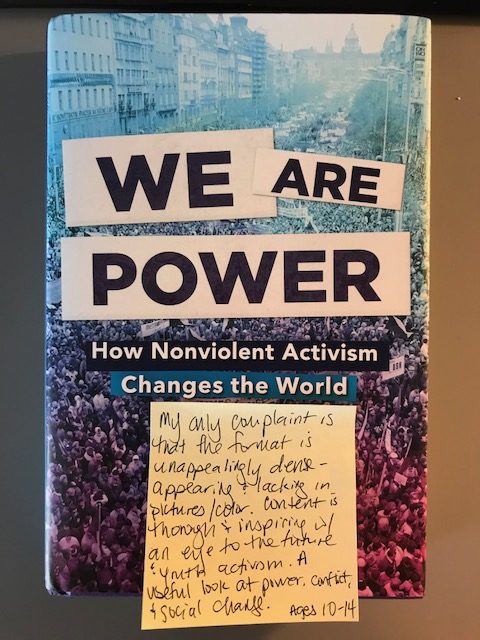
We Are Power: How Nonviolent Activism Changes the World by Todd Hasak-Lowy
A stirring look at nonviolent activism, from American suffragists to Civil Rights to the Climate Change Movement
We Are Power brings to light the incredible individuals who have used nonviolent activism to change the world. The book explores questions such as what is nonviolent resistance and how does it work? In an age when armies are stronger than ever before, when guns seem to be everywhere, how can people confront their adversaries without resorting to violence themselves? Through key international movements as well as people such as Gandhi, Alice Paul, Martin Luther King, Cesar Chavez, and Václav Havel, this book discusses the components of nonviolent resistance. It answers the question “Why nonviolence?” by showing how nonviolent movements have succeeded again and again in a variety of ways, in all sorts of places, and always in the face of overwhelming odds. The book includes endnotes, a bibliography, and an index.
(POST-IT SAYS: My only complaint is that the format is unappealingly dense-appearing and lacking in pictures/color. Content is thorough and inspiring with an eye to the future and youth activism. A useful look at power, conflict, and social changes. Ages 10-14)
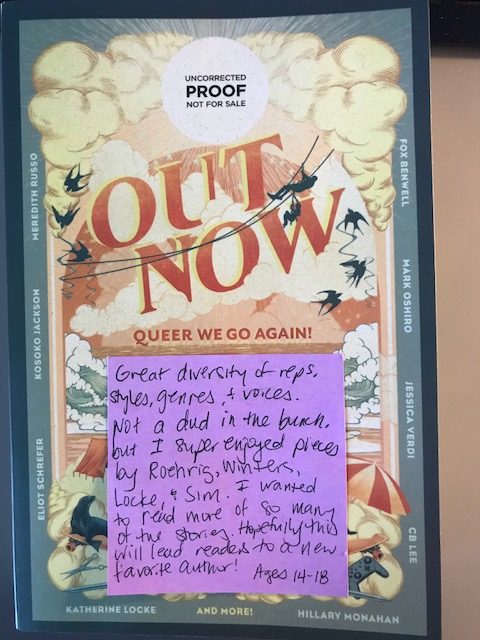
Out Now: Queer We Go Again! edited by Saundra Mitchell
QUEER WE GO AGAIN!
A follow-up to the critically acclaimed All Out anthology, Out Now features seventeen new short stories from amazing queer YA authors. Vampires crash prom…aliens run from the government…a president’s daughter comes into her own…a true romantic tries to soften the heart of a cynical social media influencer…a selkie and the sea call out to a lost soul. Teapots and barbershops…skateboards and VW vans…Street Fighter and Ares’s sword: Out Now has a story for every reader and surprises with each turn of the page!
This essential and beautifully written modern-day collection features an intersectional and inclusive slate of authors and stories.
(POST-IT SAYS: Great diversity of reps, styles, genres, and voices. Not a dud in the bunch, but I super enjoyed pieces by Roehrig, Winters, Locke, and Sim. I wanted to read more of so many of the stories. Hopefully this will lead readers to a new favorite author! Ages 14-18)
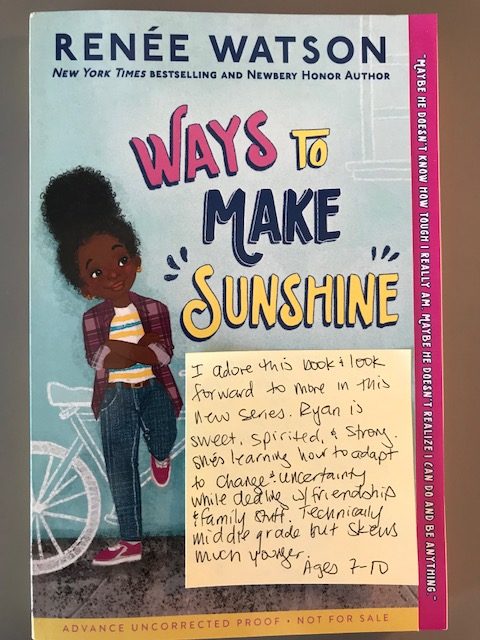
Ways to Make Sunshine by Renée Watson, Nina Mata (Illustrator)
From Newbery Honor and Coretta Scott King Author Award winner Renée Watson comes the first book in a young middle grade series about Ryan Hart, a girl who is pure spirit, kindness, and sunshine.
Ryan Hart has a lot on her mind—school, self-image, and especially family. Her dad finally has a new job, but money is tight. That means some changes, like selling their second car and moving into a new (old) house. But Ryan is a girl who knows how to make sunshine out of setbacks. As her brother says when he raps about her, she’s got the talent that matters most: it’s a talent that can’t be seen, she’s nice, not mean!
Ryan is all about trying to see the best in people, to be a good daughter, a good sister, a good friend. But even if her life isn’t everything she would wish for, when her big brother is infuriating, her parents don’t quite understand, and the unexpected happens, she always finds a way forward, with grace and wit. And plenty of sunshine.
Acclaimed author Renée Watson writes her own version of Ramona Quimby, one starring a Black girl and her family, in this start to a charming new series.
(POST-IT SAYS: I adore this book and look forward to more in this new series. Ryan is sweet, spirited, and strong. She’s learning how to adapt to change and uncertainty while dealing with friendship and family stuff. Technically middle grade but skews much younger. Ages 7-10)
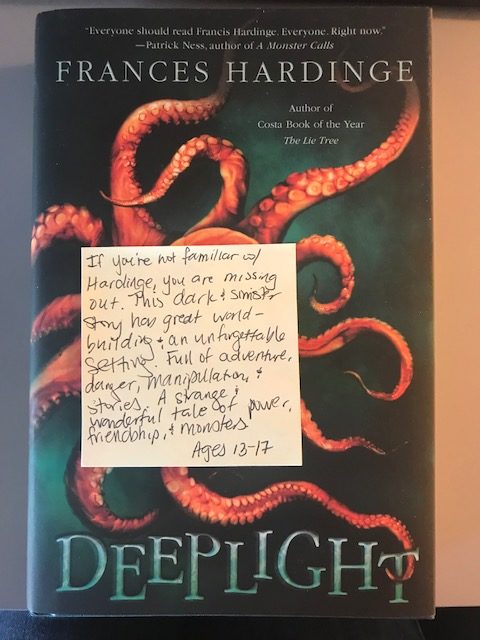
Deeplight by Frances Hardinge
Twenty Thousand Leagues Under the Sea meets Frankenstein in Frances Hardinge’s latest fantasy adventure
The gods are dead. Decades ago, they turned on one another and tore each other apart. Nobody knows why. But are they really gone forever? When 15-year-old Hark finds the still-beating heart of a terrifying deity, he risks everything to keep it out of the hands of smugglers, military scientists, and a secret fanatical cult so that he can use it to save the life of his best friend, Jelt. But with the heart, Jelt gradually and eerily transforms. How long should Hark stay loyal to his friend when he’s becoming a monster—and what is Hark willing to sacrifice to save him?
ADVERTISEMENT
ADVERTISEMENT
(POST-IT SAYS: If you’re not familiar with Hardinge, you are missing out. This dark and sinister story has great world-building and an unforgettable setting. Full of adventure, danger, manipulation, and stories. A strange and wonderful tale of power, friendship, and monsters. Ages 13-17)
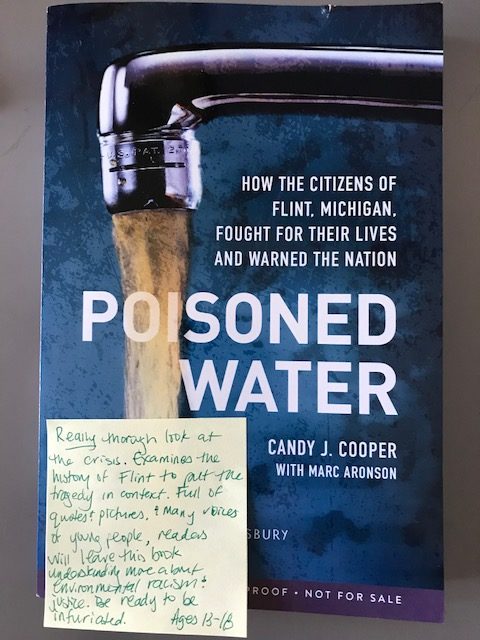
Poisoned Water: How the Citizens of Flint, Michigan, Fought for Their Lives and Warned the Nation by Candy J. Cooper, Marc Aronson
Based on original reporting by a Pulitzer Prize finalist and an industry veteran, the first book for young adults about the Flint water crisis
In 2014, Flint, Michigan, was a cash-strapped city that had been built up, then abandoned by General Motors. As part of a plan to save money, government officials decided that Flint would temporarily switch its water supply from Lake Huron to the Flint River. Within months, many residents broke out in rashes. Then it got worse: children stopped growing. Some people were hospitalized with mysterious illnesses; others died. Citizens of Flint protested that the water was dangerous. Despite what seemed so apparent from the murky, foul-smelling liquid pouring from the city’s faucets, officials refused to listen. They treated the people of Flint as the problem, not the water, which was actually poisoning thousands.
Through interviews with residents and intensive research into legal records and news accounts, journalist Candy J. Cooper, assisted by writer-editor Marc Aronson, reveals the true story of Flint. Poisoned Water shows not just how the crisis unfolded in 2014, but also the history of racism and segregation that led up to it, the beliefs and attitudes that fueled it, and how the people of Flint fought-and are still fighting-for clean water and healthy lives.
(POST-IT SAYS: Really thorough look at the crisis. Examines the history of Flint to put the tragedy in context. Full of quotes and pictures, and many voices of young people, readers will leave this book understanding more about environmental racism and justice. Be ready to be infuriated. Ages 13-18)
Filed under: Uncategorized
About Amanda MacGregor
Amanda MacGregor works in an elementary library, loves dogs, and can be found on BlueSky at @amandamacgregor.bsky.social.
ADVERTISEMENT
ADVERTISEMENT
SLJ Blog Network
Now on The Yarn: Colby’s Alaskan Children’s Book Adventure
Publisher Preview: Transit Editions (Winter 2025/26)
Exclusive: Archie Unveils New Graphic Novel Slate for Fall 2025 | News
When Book Bans are a Form of Discrimination, What is the Path to Justice?
ADVERTISEMENT







